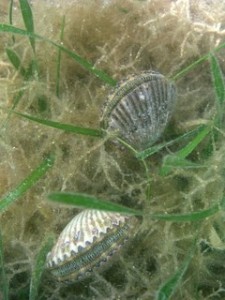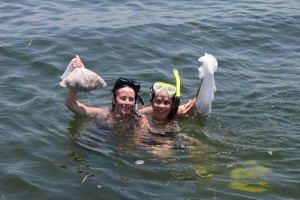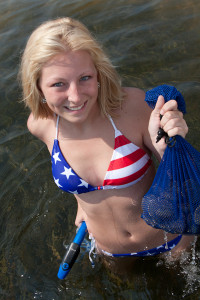Scalloping
Offshore Fishing Inshore Fishing Scalloping
When July and August roll around, the hot sun makes midday fishing miserable in Big Bend waters. However Big Bend anglers have a cooler alternative that will still let them harvest the sea’s bounty, scalloping! Scalloping is a cool activity in the midsummer’s heat because you actually get into the water and swim after them. The scalloping out of Steinhatchee is very good at this time of year. In fact that is the only time of year you can catch your own scallops, since scallop season is open from June 15th until the last day, Labor Day, and can be harvested from the Taylor County – Fenhalloway River to Dixie County – Suwannee River during this time.
The crew at Sea Hag Marina in Steinhatchee can help you get started if you have never done this before. You will need to buy a recreational saltwater fishing license before you catch scallops. The only equipment you need are a mask, swim fins, and a snorkel, plus a mesh bag for your catch. You are allowed to keep the following limits of bay scallops for our area.
June 15-30:
-
-
- Per person: 1 gallon whole bay scallops in shell or one cup shucked
- Per vessel: 5 gallons whole or two pints shucked
-
July 1-Labor Day:
-
-
- Per person: 2 gallons of whole bay scallops in shell or 1 pint of bay scallop meat
- Per vessel: Maximum of 10 gallons of whole bay scallops in shell, or 1/2 gallon bay scallop meat (1/2 gallon = 4 pints)
-
NOTE: Vessel limits do not allow an individual to exceed their personal bag limit.
 It does help to have a boat to get you to the scallops, but you can often hitch a ride with experienced friends. Most scallopers run out the Steinhatchee channel to the Gulf, or at least to marker 9, and then go either north or south for several miles until the inshore waters become clear. Favorite spots include 6 miles north (Big Grassy Island), 2-3 miles south, 4-5 miles south (Rocky Creek) and 6-7 miles south (Pepperfish Keys). You should slowly motor inshore to a water depth of 3 feet or so while staring at the bottom looking for scallops (It helps to wear polarized sunglasses!). The immediate vicinity of any large collection of boats is usually a good place to begin, for at peak scallop season 100 or more boats will be on the best spots. Don’t worry about all those boats. Scallops have been abundant in recent years and limits are easy to come by. Just keep moving around until you find an area that has not been picked over, all the while maintaining a good lookout so you don’t run over any snorkelers who often stray well away from their anchored boats.
It does help to have a boat to get you to the scallops, but you can often hitch a ride with experienced friends. Most scallopers run out the Steinhatchee channel to the Gulf, or at least to marker 9, and then go either north or south for several miles until the inshore waters become clear. Favorite spots include 6 miles north (Big Grassy Island), 2-3 miles south, 4-5 miles south (Rocky Creek) and 6-7 miles south (Pepperfish Keys). You should slowly motor inshore to a water depth of 3 feet or so while staring at the bottom looking for scallops (It helps to wear polarized sunglasses!). The immediate vicinity of any large collection of boats is usually a good place to begin, for at peak scallop season 100 or more boats will be on the best spots. Don’t worry about all those boats. Scallops have been abundant in recent years and limits are easy to come by. Just keep moving around until you find an area that has not been picked over, all the while maintaining a good lookout so you don’t run over any snorkelers who often stray well away from their anchored boats.
Scallops seem to prefer areas of bottom covered by the thin, round bladed type of sea grass more than the flat, broad-bladed turtle grass. Patches of brown algae are also favorite hiding places. Once a few scallops are seen laying on top of the sea grasses, drop the anchor, put up a dive flag (It’s the law.), and go get ’em. Scallops are easier to find when the sun is high overhead. If a tidal current is running, swim up current so you can look down, end-on between the blades of the sea grasses that have been pushed over onto their sides by the current.
Once you are done catching them, cleaning your scallops can be a chore. Sea Hag Marina has an excellent cleaning facility and often they can find someone willing to clean your catch for a small fee that is well worth every penny. One hint — chill them first. Seasoned scallopers put their scallops on lots of ice in a big cooler as soon as they’re caught. Chilled scallops will open their shells, making cleaning easy, whereas warm scallops will very effectively demonstrate the original meaning of the English verb “to clam up.” To open a scallop, use a scallop knife or sharpened spoon to cut the muscle that closes it. Hold the shell dark side up and hinge away from you. The muscle will be on your right, not far from the hinge. Insert the knife or spoon between the top and bottom shells from the right side, just in front of the hinge, and cut the muscle away from the inside of the top shell. Open the scallop and discard the top shell. Then scrape off and discard all of the innards except the sweet, white muscle about the size of the last joint of your finger. Do this by gently scraping off the dark innards, starting from the hinge side of the muscle and scraping over the muscle towards the front. Properly done, this will peel the innards from the muscle, leaving it attached to the bottom shell. Cut the muscle from the bottom shell and ice it down promptly. Have an experienced scalloper help you get started — once you learn the trick, cleaning scallops is really quite easy.
